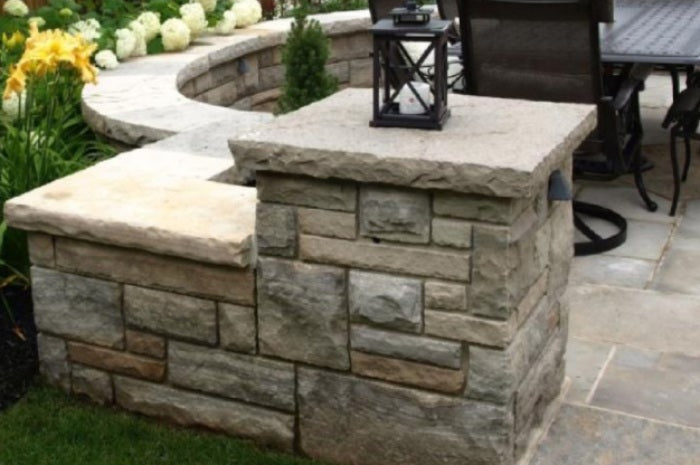10 Sandstone Wall & Pillar Caps Ideas – Trends 2021
Mar 28, 2023
Romans and other folks in the Victorian age had populated the architectural styles across the globe.
In those eras, from high-end luxury homes to the most basic spec-built homes had to have at least one column designed from antiquity.
Today in 2021, the traditional style twisted a lot and columns remained at entrance places like landscape gate, façade, porch, and similar spaces where possibilities of welcoming guests remain high.
You might have noticed one thing in common in all classical eras’ columns, which is a cap on the top. The majority of the structure made of natural stones and stone caps were a common scene.
What Is Stone Cap?
By definition in simple words, the stone cap is a stone slab placed on the top of the column, Pier, Pillar, and wall which is either in the same size as the column or extended out a bit further.

Why Do You Need Wall & Pier Caps?
I cannot sum up the answer in one sentence because capstones on piers or walls have multiple functions and those change in different contexts. For instance,
Decorative stone caps:
Have you ever looked at a wall or column in outdoor walls without a cap? It seems untidy and uniform. Some may say it is naked! Wall or pier caps are decorative at the first glance. By crafting various designs on wall caps or pillar caps stones, you can add much beauty to it.
On piers, stone caps offer a beautiful visual accent and theming look-n-feel.
Romans and Mughals have used extremely decorative stone caps on the top of walls and columns used as structural elements or decorative ones.
Protective stone caps:
Most capstones are larger in size than the components of walls or piers beneath. It is similar to humans wearing a traditional cap on the head.

Just like human caps, walls or pier stone caps are saving the structure from adversities of the weather round-the-year.
Like rainwater, heat, and snow are falling directly on the top of an outdoor wall or column, and stone caps can save the entire structure beneath from being damaged.
Cleanliness keeping stone caps:
Most of the dust, dirt, and fallen leaves drop on the stone caps and save the vertical structure beneath to look dirty. Perhaps it is the reason that the majority of boundary walls have either rounded stone caps or triangular caps pointing to the sky.
These two tactics let drop dirt and dust fall on the ground quickly. It also prevents birds from taking grip and sitting on the top of the stone cap.
Ledges

Window sills, pony walls, seat walls, retaining walls, and partition walls must have caps on the top, and stone caps are sought after elements irrespective of construction materials of walls and pillars.
Rounded, semi-rounded, or angular walls around an outdoor firepit look decent when decorated with proper stone caps. The proper width of the wall allows you, your family or your guests to sit on the wall and use it as a seat wall.
You can apply the same to different retaining and partition walls and convert those into seat walls with suitable stone types and surface finishes.
Why Do You Prefer Stone Caps?
We know modern contractors also prefer the use of natural stones in buildings besides architects and designers.
For homeowners, natural stone caps come with certain advantages, such as:
- We have sandstone walls and pillar caps with natural aesthetic appeals. Sandstone and other natural stone varieties adorned with natural beauty with grains, veins, and fissures in the stone mass and surfaces.
- Natural stone caps are sturdier than other alternatives for walls and pillar caps. So, it can bear external impacts in outdoor contexts.
- Natural stone piers and wall caps remain long-lasting and keep their charms intact for years to come. Time-worn effects also beautify the stone wall and pillar caps over time.
- Natural stones are easy to carve in desired shapes and embellish with arts of your choice. You can apply your imagination to stone caps and add more flairs to the cumulative beauty.
Which Key Characteristics Define Capstone the Best?
Shape:
At World of Stones USA, you will find extreme variations in the shapes of the wall coping or pier capstones. It may be square, rectangular, or circle shapes but always bigger than the vertical column or wall structure so it can protect all four sides.
Thickness:
However, the thickness of the capstone decides the longevity of the capstone, you will find a range of thickness from one-inch to four inches.
Surface Finishes:
In most cases, non-glossy and rough surface finishes like honed, tumbles, sand-blasted, and sawn finishes work great for wall coping or column capstones. To match with the entire vertical, we provide custom finishes on the surfaces of capstones and it depends on the finish of the vertical structure below.
Edges:
Rock face edges are a popular choice in the case of capstones, but chiseled, snapped, and bullnose types of finishes are also found in the practice. For the seat wall capstones, we prefer smooth edges like beveled or bullnose geometric variations while in the rest of the cases, machine cut or straight edges are enough.
Areas of Application of Cap Stones
Variety of applications of capstones we have noticed in our study at World of Stones USA. The following are from real-life examples.
Fire Pit Capstone

At World of Stones USA, Maryland, we proffer ready-to-use stone kits for the construction of fire pits from various stones, colors, and textures. We also provide capstones for the construction of the top layer on the firepit structure.
Capstones for Stair Columns

At the end of the stairs made of natural stone, two columns are found at the end of descending rails. We can place either a flat stone cap on those columns or décor it with crafted capstones.
Wall Coping on Peripheral Walls

Landscape designers sometimes create beautiful spaces and wall coping on the peripheral or area delineating walls look gorgeous. In the image above, the end column of a peripheral wall has been embellished with a beveled capstone on the top and placed the same wall capstones on adjoining walls to add more beauty to it.
Wall Cap Stones on Planter Walls

We often create multi-level planters on both sides of outdoor steps in our landscape or an accent to the backyard. Today trends of creating dry-walling using stacked stones are common.
To keep drywalls in place and offer additional protection, heavy and somewhat broad stone caps are being used in the construction.
Have you noticed sandstone stacked wall and wall capstones made of sandstone material give the scene a classic and traditional look?
Water Pool Coping Stones

In-ground and on-ground both kinds of water pool or water features require pool coping on the top of the pool walls. Rock-facing cuts of pool coping stones seem the most natural.
However, to gain smooth surfaces, we at World of Stones USA offer bullnose coping stones with rough to smooth finishes.
Wall Cap Stones on the Top of Retaining Walls in Landscape
Right from the ancient eras, we are using dry stone walling or dry-stacked stones to create retaining walls in our landscape designs in the gardens. Sandstone always remains our choice of material to create retaining walls, steps, and mini-columns.
Placing almost four to six inches thick capstones on the top of the dry sandstone stone walls makes the structure neat in shape and gives functional utility to use as a seat wall for garden goers.
Wall Coping Stones on Curved Retaining and Pony Walls

Have you noticed the sophistication of sandstone retaining and pony walls to define different elevations in the landscape?
This one is, of course, dry stone walling, but sandstone pieces have been cut in a highly precise way and stacked capstone makes the entire structure neat and attractive.
Wall Cap Stones on Partition Walls in Your Landscape

Every designing element in this outdoor space is made of sandstone material including, paver stones, wall stones, and wall capstones. Here the designer has used thin wall caps with natural cleft finishes to give the structure a designing beauty.






